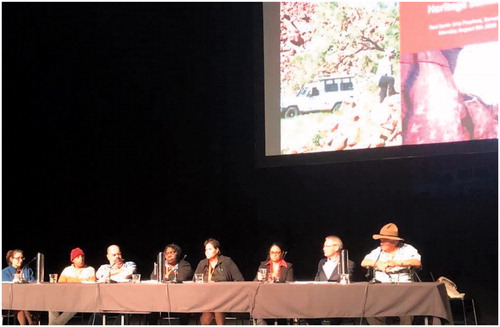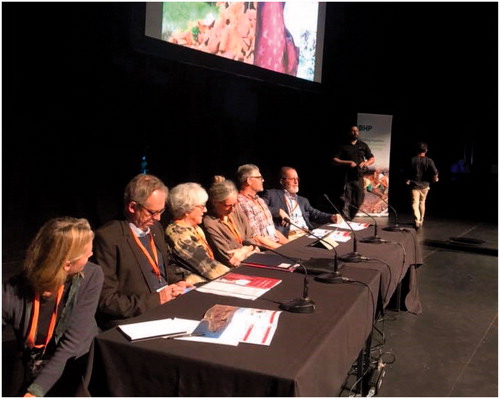August 2018 was a big month for heritage in Western Australia. On the 27th August, WA’s Premier McGowan announced that the State Government will act on the request by Murujuga Aboriginal Corporation (MAC) to nominate the Dampier Archipelago (including the Burrup Peninsula, known to the local custodians as Murujuga) to UNESCO’s World Heritage List (WHL). This was quickly followed by an announcement from the then Environment Minister, Hon. Stephen Dawson, that a new Burrup Rock Art Stakeholder Reference Group had been formed, in an effort to reinvigorate understanding of the rock art of Murujuga and the monitoring of its potential damage from industrial emissions. The first meeting of this reference group was held on 1st September. These events followed hot on the heels of a World Heritage Summit convened in Karratha on 6th August, coinciding with the Southern Deserts 5 conference. Held over four days, this international conference was attended by over 80 delegates, including international and Australian archaeologists and climate scientists, local Aboriginal people, heritage professionals and media.
This flurry of activity around Murujuga represents a significant moment in the history of heritage management in Western Australia, a state with no cultural sites on the World Heritage List, and one which is currently undergoing fundamental changes in the way that Aboriginal heritage is managed (https://www.dpc.wa.gov.au/lantu/Agreements/Pages/BurrupAgreement.aspx). It is a significant moment for the Aboriginal people of the coastal Pilbara, who ceded their native title claims to the Dampier Archipelago through the state-based Burrup and Maitland Industrial Estates Agreement Implementation Deed (the BMIEA). Under the BMIEA, the five Aboriginal groups, (Ngarluma, Yindjibarndi, Yaburara, Mardudhunera and Wong-gg-tt-too), most of whom hold Native Title in adjacent lands, are represented by the Murujuga Aboriginal Corporation (MAC) as the custodial owners of this heritage estate. The BMIEIA, while extinguishing Native Title, commits the WA state Government to establishing and resourcing an effective and inclusive management regime to protect the natural, cultural and recreational values of Murujuga. Murujuga National Park is a small part of the larger National Heritage Listed place (http://www.environment.gov.au/heritage/places/national/dampier-archipelago), which is administered by the Commonwealth. The Environment Protection and Biodiversity Conservation Act (EPBCA) provides protection for this heritage estate, for both national and World Heritage listings.
So why is this such an important moment for heritage management in the West?
The World Heritage Summit involved Traditional Custodians, heritage specialists and other interested community stakeholders (http://www.abc.net.au/news/2018-08-06/tim-winton-joins-push-for-world-heritage-listing-of-rock-art/10071998). The aim of this summit was to identify this place’s cultural values and allow the Aboriginal community to express their aspirations for the archipelago. All local traditional custodian groups were represented on a local community panel (). These representatives spoke passionately and with one coherent voice about the significance of this place and their desires for increased protection of the archipelago and its rock art. Tim Winton – as patron for the summit – spoke cogently about the values of this place and Australia’s need to recognise the value of its natural and cultural estates. The summit provided a forum for heritage experts with broader experience of the World Heritage regime to explain to the Aboriginal community the pros and cons of World Heritage Listing. Heritage experts who represent Australia at UNESCO, who have served on the Australian Heritage Council, and who have worked with international communities (in Cambodia, Vanuatu and the Pacific), brought varying insights to the processes and challenges of World Heritage ().
Figure 1. The Summit’s Aboriginal panel, including Daryl Pappin and Denis Rose (left), Tootsie Daniel, Raelene Cooper, Audrey Cosmos and Wilfred Hicks.

Figure 2. The summit’s expert heritage panel of (L to R) Meredith Wilson, Richard Mackay, Carmen Lawrence, Anita Smith, Steve Brown and Stephen Oxley.

The summit also highlighted recent research findings of a collaboration by University of Western Australia (UWA) researchers with the Aboriginal community and industry partner, Rio Tinto Iron Ore (RTIO) (ARC Linkage Project Murujuga: Dynamics of the Dreaming), which has produced a number of significant findings on the scientific values of the place. This summit was a direct spin-off from that project, with co-convenors, Peter Jeffreys (Senior Cultural Custodian), Ken Mulvaney (archaeologist with RTIO) and I (UWA) representing the three prongs of that collaboration. The resounding conclusion of the summit from Aboriginal people, researchers, industry and community was that World Heritage Listing would be appropriate recognition for Murujuga rock art and that it would probably afford better protection for this significant cultural landscape.
This set of heritage outcomes represents a victory for archaeology as a collaborative endeavour for community, academia and industry. Similarly, it signals a heritage success for public advocacy (e.g. by Friends of Australian Rock Art, Get-Up, and Stand-Up for the Burrup: e.g. http://www.standupfortheburrup.com/). The Senate Inquiry held last year into industry emissions and rock art protection (https://www.aph.gov.au/Parliamentary_Business/Committees/Senate/Environment_and_Communications/BurrupPeninusla [sic]), was spurred by concern that the monitoring of emissions was not being undertaken or overseen in an appropriate manner. This enquiry was another milestone in the recognition of the values of the Murujuga landscape (https://theconversation.com/where-art-meets-industry-protecting-the-spectacular-rock-art-of-the-burrup-peninsula-72964); while the various political parties (Coalition, Labour and Greens) wrote competing recommendations and findings, all were agreed on the significance of the rock art and the need to protect it.
The announcement that the Murujuga inscribed land- and seascape is to be added to Australia’s Tentative List of the WHL is not the end of the story. Australia can only nominate one heritage property to the Tentative List each year. UNESCO then takes several years to assess properties on the Tentative List sequentially to ensure that these meet their Outstanding Universal Value criteria. However, the actions of the last month do signal a sea-change to a more positive heritage journey. It shows the power of public opinion and action and the strength of heritage achieved as collaboration between western science and Indigenous knowledge. We are no longer in the 1960s, when this place was first selected for industrial development in ignorance of its cultural or scientific significance. It is time that all Australians recognise and celebrate the Indigenous cultural assets of this nation and foreground these in our efforts to balance economic development and heritage protection and management. We may yet avoid becoming known as the “culture” which managed to destroy, in 50 years, a visual and cultural record, which was created over 50 millennia.
Centre for Rock Art Research + Management University of Western Australia
[email protected]
